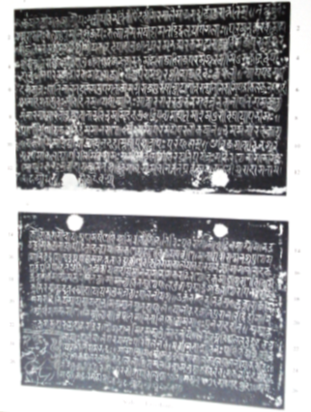|
The Indian Analyst
|
North Indian Inscriptions |
INSCRIPTIONS OF THE PARAMARAS OF BHINMAL ... The inscription is sectarian and its purpose is to record that during the reign of the Mahārāja-putra Jayatsiṁha at Śrīmāla, one Aravasāka, a son of Paramahidā, presented one dramma, in cash, to Vālākadēva (i.e., Bālārkadēva) and another dramma was offered to the same deity by his wife. The date, which is mentioned in figures in 1. 1, is Wednesday, the tenth of the dark half off Āśvina of the (Vikrama) year 1239; and the corresponding Christian date is either 25th August of 1182 A.C., or 12th October, 1183 A.C. [1] ... The inscription opens with the date which we have seen above, and then records the presents in 11. 2-7. Lines 7-8 also impose one dramma to be offered to the deity by some other persons, and 11. 9-10 state that whosoever be the king here (i.e., at Śrīmāla) in future, he should offer one dramma annually to the same god. [ 2] ... Though not a royal record, this is the only inscription which is so far known to reveal the name of Jayatsiṁha who was ruling over the region around Śrimāla, or Bhinmāl, in the last quarter of the twelfth century A.C. And though nothing about his family or pedigree is given in the record, the very mention of the locality, which was under the Paramāras of Bhinmāl, unquestionally shows him to be a successor of Kṛishṇarāja, who, as known form the two preceding inscriptions, was ruling there in 1060 and 1067 A.C. It may also be assumed that he was a son of Kṛishṇarāja, ...The view that Jayatsiṁha was a scion off this house is merely tentative, resting on the provenance of the inscription. On the other hand, in his I.N.I. (No.397), D.R. Bhandarkar took him as belonging to the Nāḍōl Chāhamāna branch ; and this view is probably based on the evidence of the Sādaḍī inscription of V.S. 1251 (I.N.I., No. 429), mentioning one Jayatsiṁha as a son of Kēlhaṇa. But we have no evidence to show that Bhinmāl was then included in the Nāḍōl territory. We have also a record of one Mahārājadhirāja Samarasiṁha of the Sōnigirā branch of the Chāhamānas, dated in the same year of the present inscription (I.N.I., No. 396), at Jālōr, which is only about 50 kms. north by east of Bhinmāl, which may have then been included in it. Thus, nothing can be definitely said, until fresh evidence is forthcoming.
... Jayatsiṁha, if he was at all a member of this line, was the last of the rulers belonging to this branch of the Paramāra house. His son was Salakha, whose name is known from the Rāsamālā; [3] but whether he actually occupied the throne is not known from any of the epigraphic records.The above view too is not certain, for on the other hand, we find that the Jālōr Chāhamāna Udayasiṁha, whose inscriptions bear dates extending from 1205 to 1249 A.C. and whose record dated 1206 A.C. is from Śrīmāla itself, appears to have ended the career of this junior branch of the Paramāras who were powerful in this region for about two centuries. Their career ended almost simultaneously with the other junior branch holding its sway at Jālōr. Thus, the present record belongs to the Chāhamāna house, as actually taken by D.R. Bhandarkaar. [4] Neither of these views, however, is certain, unless it is corroborated from any other evidence. ... The only place-names mentioned in the inscription in 1. 3 is Śrīmāla, which is no other then the town of Bhinmāl, as we have so often seen and where the inscription was found.
TEXT
[5]
[1] Respectively for the expired and the current Vikrama years, as calculated by F. Kielhorn in his List of inscriptions in Ep. Ind., Vol. V. appx., No. 696. As the day was the same on both the tithis, it cannot be ascertained whether the record was put to stone in the expired or the current year.
CORPUS INSCRIPTIONUM INDICARUM
|
||||||||||||||||||||||||||||||||||||||||||||||||||||||||||||||||||||||||||||||||||||
| > |
|
>
|









